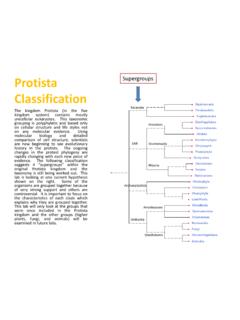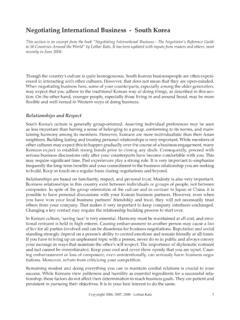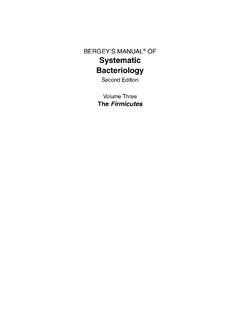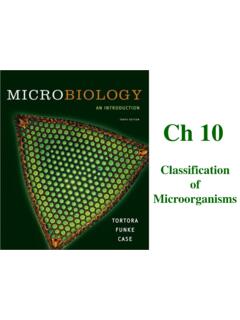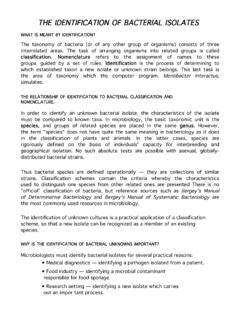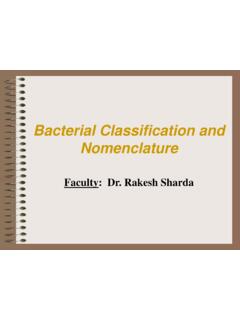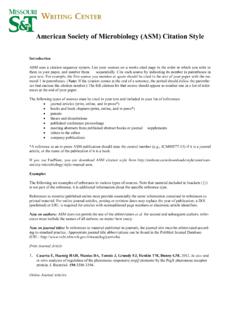Transcription of Classification of Microorganisms
1 Classification of Microorganisms By Dr. Carmen Rexach Mt San Antonio College Microbiology Taxonomy Science of Classification of organisms Aids in categorizing organisms not yet studied in detail Aids in identifying already classified organisms Provides common frame of reference when organisms are discussed Phylogeny Evolutionary history of an organism Father of taxonomy Linneaus Grouped organisms by characteristics into taxa =. taxonomic categories Darwin Studies on evolution Readjustment of organisms in taxa based on degrees of relatedness to each other How should we classify bacteria? Originally in the Kingdom Plantae Division Schyzomycetes (Carl von Nageli, 1857). Ernst Haeckel Kingdom Protista, suggested bacteria should be placed here, but remained in Kingdom Plantae Edward Chatton Introduced term prokaryotae in 1937 = cells without a nucleus Roger Stanier Adjusted definition to include organisms without a nuclear envelope RGE Murray Proposed Kingdom Prokaryotae in 1968.
2 Timeline 1735 Plant & Animal Kingdoms 1857 Bacteria & fungi put in the Plant Kingdom 1866 Kingdom Protista proposed for bacteria, protozoa, algae, and fungi 1937 Prokaryote introduced for cells "without a nucleus". 1961 Prokaryote = cells in which nucleoplasm is not surrounded by a nuclear membrane 1959 Kingdom Fungi 1968 Kingdom Prokaryotae proposed 1978 Two types of prokaryotic cells found The Three-Domain System Table The Three-Domain System Figure Five Kingdom System of RH. Whittaker (1969). Kingdom Prokaryotae/Monera Kingdom Protista Kingdom Fungi Kingdom Plantae Kingdom Animalia Kingdom Prokaryotae/Monera Precursor to all eukaryotes Eubacteria, archaebacteria, cyanobacteria Has now been reassigned to two Kingdoms: Bacteria and Archaea Kingdom Bacteria Prokaryotes Peptidoglycan cell walls Binary fission Energy source: organic chemicals, inorganic chemicals, or photosynthesis H.
3 Influenza Kingdom Archaea Extreme living conditions Unusual metabolism No peptidoglycan in cell walls Examples methanosarcinae Methanogens Halophiles thermoacidophiles Anamox Kingdom Protista Primarily unicellular eukaryotes Protozoa, algae, slime molds, water molds Kingdom Fungi Unicellular yeasts Multicellular molds Mushrooms Saprophytes with hyphae Kingdom Plantae Some alga, mosses, ferns, conifers, flowering plants Multicellular Photosynthetic (autotrophs). Kingdom Animalia Sponges, worms, insects, chordates Heterotrophic multicellular Algae Some unicellular, some multicellular Kingdom Protista, Kingdom Archaea, and Kingdom Plantae! photoautotrophs Tropical red algae Viruses Acellular DNA or RNA, not both at same time Protein capsid Some have envelope and other external structures Obligate intracellular parasites Three Domain System of Carl Woese (1978).
4 Based on molecular biology and recognition that ribosomal differences suggest two types of prokaryotes Eukarya, prokarya, archaea Sometimes organized as empires or domains = a category above kingdom Kingdoms in three domain system Recent discoveries in molecular biology have suggested division in Kingdom Protista New Classification scheme Domain Bacteria Kingdom Bacteria Domain Archaea Kingdom Archaea Domain Eukarya Kingdom Archaezoa Kingdom Plantae Kingdom Euglenazoa Kingdom Fungi Kingdom Alveolata Kingdom Animalia Kingdom Stramenopila Kingdom Rhodophyta Scientific Nomenclature Carolus Linnaeus Binomial nomenclature: genus + species italicized or underlined. genus is capitalized specific epithet (species) is lower case. Latinized . used worldwide Scientific nomenclature Naming bacteria Names can describe characteristics or honor pioneer in field Rules established by International Committee on Systemic bacteriology = Bacteriological Code Bergey's Manual contains description and rules Compiled from publications in International Journal of Systemic bacteriology Change as new techniques disclose similarities and differences Examples Staphylococcus aureus Describes the clustered arrangement of the cells (staphylo-) and the golden color of the colonies (aur-).
5 Escherichia coli Honors the discoverer, Theodor Escherich, and describes the bacterium's habitat the large intestine or colon. After first use, can be abbreviated as: S. aureus and E. coli . Scientific names Scientific Binomial Source of Genus Source of Name Specific Epithet Klebsiella pneumoniae Honors Edwin Klebs The disease Pfiesteria piscicida Honors Lois Disease in fish Pfiester Salmonella Honors Daniel Stupor (typh-) in typhimurium Salmon mice (muri-). Streptococcus Chains of cells Forms pus (pyo-). pyogenes (strepto-). Penicillium Tuftlike (penicill-) Produces a yellow chrysogenum (chryso-) pigment Trypanosoma cruzi Corkscrew-like Honors Oswaldo (trypano-, borer; Cruz soma-, body). Taxonomic hierarchy Kingdom Phylum or Division Class Order Family Genus Species What is a species? Eukaryotic species: A group of closely related organisms that breed among themselves Prokaryotic species: A population of cells with similar characteristics Clone: Population of cells derived from a single cell Strain: Genetically different cells within a clone Viral species: Population of viruses with similar characteristics that occupies a particular ecological niche How to determine phylogenetic heirarchy Generally determined by fossil records for higher organisms Not available for most microbes with following exceptions White Cliffs of Dover in England Fossilized remains of marine Stromalites: Hamilin Bay, Australia protists Stromalites Fossilized microbial communities up to 2 billion years old Cyanobacterial fossils Found in Australia billion years old Classifying bacteria.
6 Bergey's Manual of systematic bacteriology 4 divisions Distinguished by cell wall structure 7 classes 3 eubacterial 4 archaeobacterial Bacterial species Population of cells with similar characteristics Strain Variation within a species Race, clade (ex) E. coli 0157:H7. Viral Classification Viral species Population of viruses with similar characteristics occupying a particular ecological niche Where should they be placed? Are they even alive? Will you be able to defend your position on an exam? Classification of bacteria Bergey's manual Amino acid sequencing Morphology PAGE. Differential staining Base composition of nucleic acid Biochemical tests DNA fingerprinting Serology PCR. Western Blot Nucleic Acid Phage typing hybridization Flow cytometry Using Bergey's Manual Approx 1800 bacteria classified, <200. human pathogens Four volumes 1.
7 Wall-less eubacteria and some gram-negative eubacteria 2. Gram positive eubacteria 3. Gram negative eubacteria Photosynthetic, chemolithotropic, sheathed, budding, appendaged, gliding, and fruiting bacteria archaeobacteria 4. Actinomycetes Morphology Not as dominant in Classification as in higher organisms because few shapes Many biochemical differences Structures that occasionally help in identification Spore formation Orientation of flagella, etc. Differential staining Distinguish between gram positive & gram negative, acid fast &. non-acid fast Very general Refers only to cell wall structure Some bacteria have no cell wall, or unusual ones Biochemical tests Distinctions based on biochemicals the organism can utilize or metabolize Ex) lactose or glucose fermentation, inositol production, lipid utilization, production of gas, etc.
8 API strips, Enterotube II. Degree of turbidity or color change Serology Blood serum, looking at immune response Can distinguish strains in give species = very sensitive Antisera = contains antibodies for antigen of interest Slide agglutination test Place unknown in saline on slide and add anti- sera Agglutinates if reaction is positive ELISA. Fast, can be scanned by computer Antibodies embedded in wells Add sera containing unknown antigen ELISA Latex Agglutination Test Latex agglutination Western Blot Electrophoresis separates proteins in patient's serum Transfer proteins onto nitrocellulose filter by blotting Wash filter with antibodies tagged with dye Presence of antigen appears as colored band Western Blot Western blot for lyme disease Phage typing Uses specificity of certain bacteriophage for particular bacteria to identify it Method Grow a lawn Inoculate Look for plaques Phage typing Amino acid sequencing More similar indicates closer phylogenetic relationship Farther apart = more distant Compare the amino acid sequence of same protein in two organisms to determine the degree of similarity Can only be used when organisms have common proteins Possibility
9 Exists that two unrelated organisms can produce same protein with same code Sequencer PAGE. polyacrylamide gel electrophoresis Premise: Genes determine protein sequence Procedure: Lyse cells, extract protein and dissolve in detergent Place sample into a polyacrylamide gel Electrophoresis separates out protein by charge and size Stain gel and compare banding patterns PAGE. Base composition of nucleic acids Compare the percentage of certain bases in nucleic acids of two organisms Calculate the common ratio of: G+C/A+T+G+C. PCR= polymerase chain reaction Amplify DNA. Especially useful in microbes that cannot be cultured Also where limited amount of DNA is available DNA fingerprinting Amplify specific regions of DNA. using PCR, or cut DNA from organism with restriction enzymes Compare number and size of fragments after separation by gel electrophoresis DNA fingerprinting using primer/PCR.
10 Nucleic acid hybridization Separate double stranded DNA from two organisms into single strands by using heat Allow them to cool together Will anneal at complementary bases Measure degree of similarity Can also compare DNA from one organism with RNA from another = Southern Blotting Hybridization + Probe Flow cytometry Run cells through narrow tube in liquid medium so that only one cell moves through at at time Hit each cell with laser Determines shape, size, surface, density, fluorescence, etc. Results recorded by computer Determine similarity Flow cytometry Numerical taxonomy Assign numerical values for each of the tests Put info into computer Compare degrees of similarity for a number of characteristics 90% similarity or greater signifies same species Subjective because? Dichotomous Key UN Cladogram Figure , steps 1 2.


